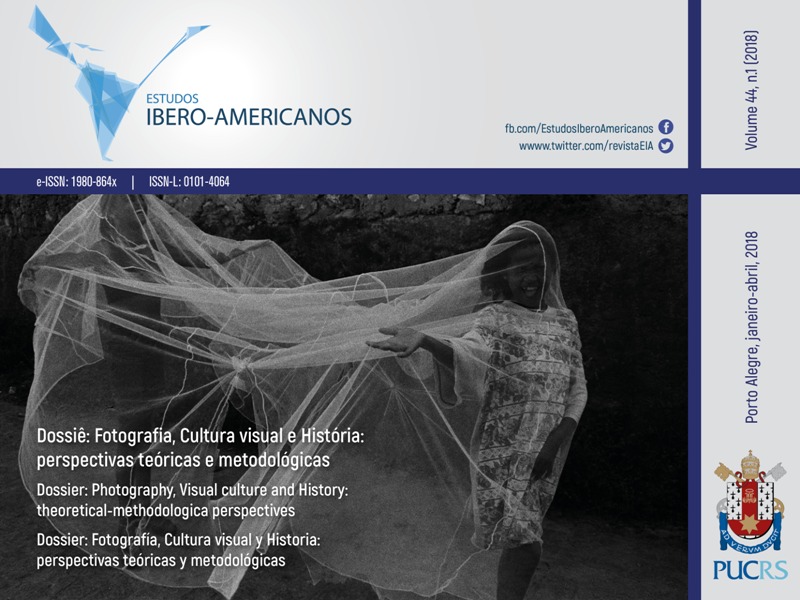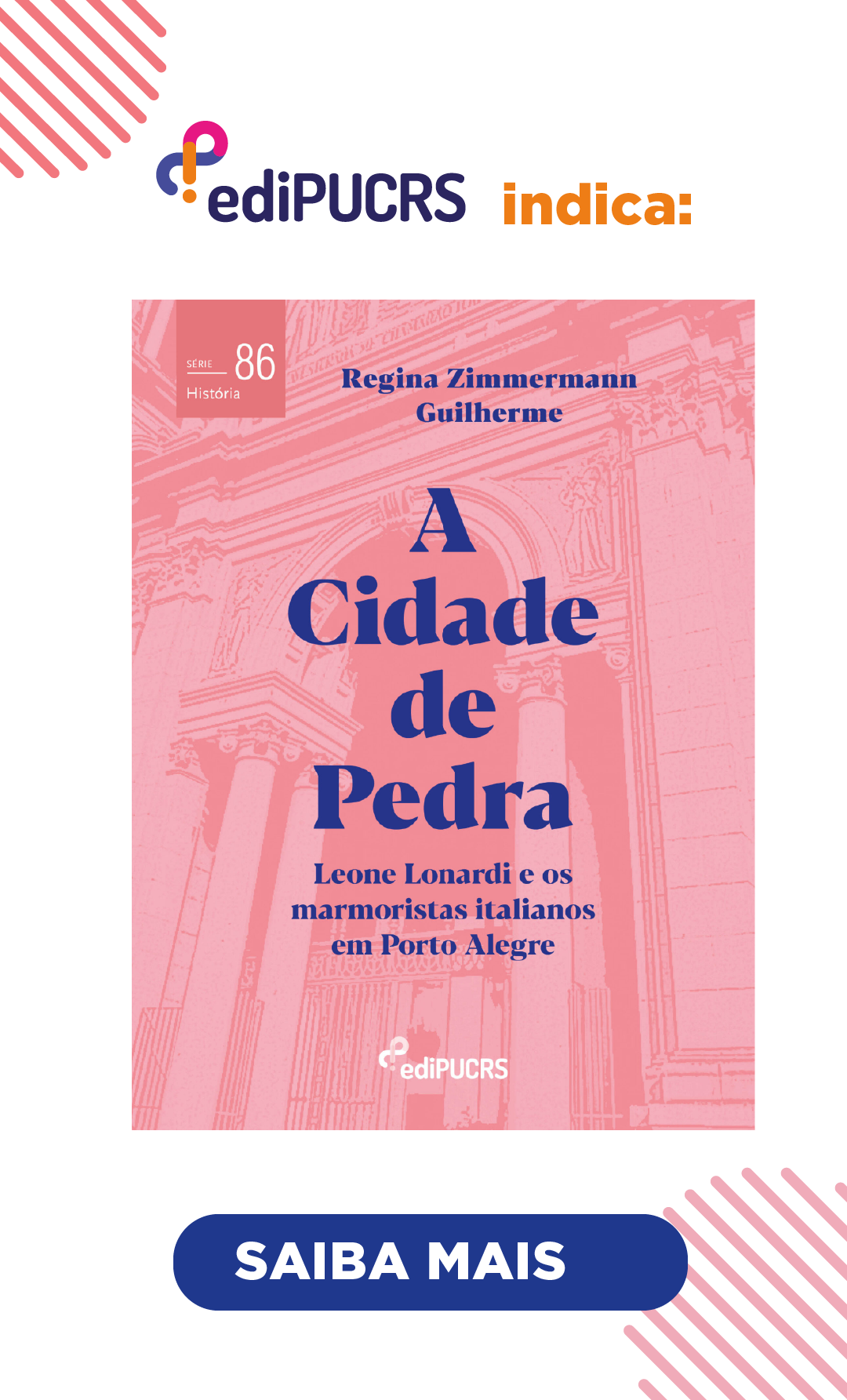Analyzing Historical Photographs: Genres, Functions, and Methodologies
DOI:
https://doi.org/10.15448/1980-864X.2018.1.27785Palavras-chave:
fotografias históricas, fotojornalismo, gênerosResumo
***Análise de fotografias históricas: gêneros, funções e metodologias***
O artigo opera com os conceitos de genero e função como contribuição no desenvolvimento de metodologias para analisar fotografias desde uma perspectiva histórica. Examina-se o gênero fotojornalismo considerando-se suas diferentes funções delimitadas por suas diversas dimensões, entre as quais: fotografia de imprensa, fotojornalismo propriamente, fotoensaios e documentarismo. Observa-se que os enganos gerados pelos praticantes desse gênero fotográfico são resultado da aplicação das regras de uma única função a todo o gênero. Assume-se a hipótese que a análise histórica pode facilitar o estabelecimento dos gêneros fotográficos e a distinção das diferentes funções dentro de um gênero.
Downloads
Referências
ANTONIORROBLES. En la ruta de Paco Mayo. Ma-ana, Mexico City, n. 449, p. 40-44, Apr. 1952.
AZOULAY, Ariella. Civil Imagination: A Political Ontology of Photography. Trans. Louise Bethlehem. London: Verso, 2012.
BARTHES, Roland. Camera Lucida. Trans. Richard Howard. New York: Hill and Wang, 1981.
BATESON, Gregory. Steps to an Ecology of Mind. New York: Ballantine Books, 1972.
BENJAMIN, Walter. The Work of Art in the Age of Mechanical Reproduction. In: LANG, Berel; WILLIAMS, Forrest (Ed.). Marxism and Art: Writings in Aesthetics and Criticism. New York: David McKay, 1972. p. 281-300.
BERGER, John. Understanding a Photograph. Edited by Geoff Dyer. London: Penguin Books, 2013.
BOURDIEU, Pierre. Photography: A Middle-brow Art. Trans. Shaun Whiteside. Cambridge: Polity Press 1990. Costa LIMA, Luiz. The Dark Side of Reason: Fictionality and Power. Trans. Paulo HenriquesBritto. Palo Alto: Stanford University Press, 1992.
CURTIS, James. Mind's Eye, Mind's Truth: FSA Photography Reconsidered. Philadelphia: Temple University Press, 1989.
DE LA PEÑA, Ireri (Ed.). Ética, Poética y Prosaica. Ensayos sobre fotografía documental. Mexico City: Siglo XXI, 2008.
DERRIDA, Jacques. The Law of Genre. Glyph: Johns Hopkins Textual Studies, Baltimore, n. 7, p. 202-232, 1980. Escorza RODRÍGUEZ, Daniel. Agustín Víctor Casasola. El fotógrafo y su agencia. Mexico City: INAH, 2014.
FULTON, Marianne. Eyes of Time: Photojournalism in America. Boston: Little, Brown, and Co., 1988.
GALEANO, Eduardo. Memoria del fuego. Three volumes. Mexico City: Siglo XIX, 1982-1986.
HIRSCH Jr., E. D. Validity in Interpretation. New Haven: Yale University Press, 1967.
HORTON, Brian. The Associated Press. Photojournalism Stylebook. The News Photographer's Bible. New York: Addison- Wesley, 1990.
KOZOL, Wendy. Life's America: Family and Nation in Postwar Photojournalism. Philadelphia: Temple University Press, 1994.
LÓPEZ, Nacho. Letter to Manuel Berman, 1 August 1980, Archivo Documental Familia López Binnqüist (ADFLB).
______. Yo, el ciudadano. Mexico City: Fondo de Cultura Económica, 1984.
______. 'Yo también he sido ni-o bueno…', un reportaje de Nacho López. Ma-ana, Mexico City, n. 383, p. 20-26, Dec. 1950.
______. Winfield Scott: Retrato de un fotógrafo norteamericano en el porfiriato. Mexico City: Universidad Autónoma Metropolitana, 2012.
Marzal FELICI, Javier. Cómo se lee una fotografía. Interpretaciones de la mirada. Madrid: Cátedra, 2015.
MOYA, Rodrigo. Unpublished manuscript. Las imágenes prohibidas. ENCROME 4, “Proyecto ENsayo-CRÓnica-MEmoria”, Archive of Rodrigo Moya.
MRAZ, John. “En calidad de esclavas”: obreras en los molinos de nixtamal, México, diciembre, 1919. Historia Obrera, Mexico City, v. 6, n. 24, p. 2-14, Mar. 1982.
______. Los Hermanos Mayo: el Primero de Mayo y la fotografía de la clase obrera. Boletín de investigación del movimiento obrero, Puebla, n. 11, p. 105-115, Mar. 1988.
______. Tina Modotti: en el camino hacia la realidad. La Jornada Semanal, Mexico City, n. 7, p. 20-23, July 1989.
______. Cuban Photography: Context and Meaning. History of Photography, London, v. 18, n. 1, p. 87-96, Spring 1994. <https://doi.org/10.1080/03087298.1994.10442333>
______. Mexico: The New Photojournalism. History of Photography, London, v. 22, n. 4, p. 313-365, Winter 1998.
______. Sebastião Salgado: Ways of Seeing Latin America. Third Text, v. 16, n. 1, March 2002, 15-30. <https://doi.org/ 10.1080/09528820110120687>
______.What's Documentary about Photography? From Directed to Digital Photojournalism. In: Zonezero Magazine, 2002. Available at: . Accessed on: 29 May 2017.
______. Nacho López: Mexican Photographer. Minneapolis: University of Minnesota Press, 2003.
______. From Robert Capa's “Dying Republican Soldier” to Political Scandal in Contemporary Mexico: Reflections on Digitalization and Credibility. In: Zonezero Magazine, 2004. Available at: . Accessed on: 29 May 2017.
______. Looking for Mexico: Modern Visual Culture and National Identity. Durham: Duke University Press, 2009.
______. Photographing the Mexican Revolution: Commitments, Icons, Testimonies. Austin: University of Texas Press, 2012.
MRAZ, John; VÉLEZ STOREY, Jaime. Uprooted: Braceros in the Hermanos Mayo Lens. Houston: Arte Público Press, 1996.
MRAZ, John et al. Walter Reuter. El viento limpia el alma. Barcelona, Lunwerg, 2009.
Nacho López, fotorreportero de los a-os cincuenta. Mexico City: CONACULTA, 1989.
PICAUDÉ, Valérie; ARBAÏZAR, Phillippe (Eds.). La confusión de los géneros en fotografía. Barcelona: Gustavo Gili, 2004. “Polémica y debate abierto,” Sexta Bienal del Fotoperiodismo, Mexico City, 2004. Available at: <http://www.fotoperiodismo.org>. Accessed on: 29 May 2017.
RODRÍGUEZ, José Antonio; TOVALÍN AHUMADA, Alberto (Eds). Nacho López, ideas y visualidad. Mexico City-Veracruz: INAH-Fondo de Cultura Económica-Universidad Veracruzana, 2012.
______. Nacho López. Fotógrafo de México. Mexico City: Museo del Palacio de Bellas Artes, 2016.
ROSLER, Martha. In, around, and afterthoughts (on documentary photography). In: BOLTON, Richard (Ed.). The Contest of Meaning: Critical Histories of Photography. Cambridge, MIT Press, 1989. p. 303-341.
SAUNDERS, Dave. 20th Century Advertising. London: Carlton, 1999.
SCHULTZ, Reinhard (Ed.). Tina Modotti: Photographien & Dokumente. Berlin: Sozialarchiv, nd [1989].
SEKULA, Alan. Dismantling Modernism, Reinventing Documentary. The Massachusetts Review, Amherst, v. 19, n. 4, p. 859-883, 1978.
SOLOMON-GODEAU, Abigail. Who is Speaking Thus? Some Questions About Documentary Photography. In: FALK, Lorne and FISCHER, Barbara Fischer (Eds.). The Event Horizon. Toronto, Coach House Press, 1987. p. 193-214.
SONTAG, Susan. On Photography. New York: 1973.
STEIN, Sally. Making Connections with the Camera: Photography and Social Mobility in the Career of Jacob Riis. Afterimage, Rochester, v. 10, n. 10, p. 9-16, May 1983.
STOTT, William. Documentary Expression and Thirties America. London: Oxford University Press, 1986.
TODOROV, Tzvetan. The Origen of Genres. New Literary History, Baltimore, n. 8, v. 1, p. 159-170, 1976.
______. The Typology of Detective Fiction. In: The Poetics of Prose. Ithaca: Cornell University Press, 1977. p. 42-52.
VILCHES, Lorenzo. Teoría de la imagen periodística. Barcelona: Ediciones Paidós, 1987.
WILLUMSON, Glenn W. W. Eugene Smith and the Photographic Essay. Cambridge: Cambridge University Press, 1992.
Downloads
Publicado
Como Citar
Edição
Seção
Licença
Copyright (c) 2018 John Mraz

Este trabalho está licenciado sob uma licença Creative Commons Attribution 4.0 International License.
Direitos Autorais
A submissão de originais para a Estudos Ibero-Americanos implica na transferência, pelos autores, dos direitos de publicação. Os direitos autorais para os artigos publicados nesta revista são do autor, com direitos da revista sobre a primeira publicação. Os autores somente poderão utilizar os mesmos resultados em outras publicações indicando claramente a Estudos Ibero-Americanos como o meio da publicação original.
Licença Creative Commons
Exceto onde especificado diferentemente, aplicam-se à matéria publicada neste periódico os termos de uma licença Creative Commons Atribuição 4.0 Internacional, que permite o uso irrestrito, a distribuição e a reprodução em qualquer meio desde que a publicação original seja corretamente citada.






